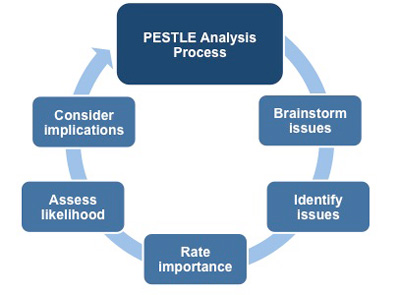PESTLE Factors

The purpose of the PESTLE Analysis is to identify issues that fit two key criteria:
1. They are outside the control of your organization
2. They will have some level of impact on it
All discussions must be carefully controlled to keep the focus on identifying issues rather than trying to resolve them. You will need to consider the implications of any factors you identify as well as the likelihood of them occurring, but you must avoid falling into the trap of debating possible solutions or strategies.
 |
The process you are likely to adopt when using the PESTLE technique is a relatively simple one:
- Brainstorm and list key issues that are outside the organization's control.
- Broadly identify the implications of each issue.
- Rate its relative importance to the organization (e.g. critical, extensive, important, significant, moderate, or insignificant).
- Rate the likelihood of it occurring (e.g. certainty, extremely likely, likely, potential, remote possibility, or will not transpire).
- Briefly consider the implications if the issue did occur.
This process should give you a much clearer understanding of your environment. This view of the 'big picture' enables you to assess the potential risks that you face and can also be used to gauge what impact current external factors will have. This is referred to as using the PESTLE as a generic 'orientation' tool.
Remember, the responsibility of suggesting solutions to each issue is outside the scope of the PESTLE Analysis. Its sole purpose is to audit your organization's environment so that strategic decisions can be made once each issue has been fully researched.
As already mentioned, there are six factors that form the framework of this analysis. These Political, Economic, Sociological, Technological, Legal, and Environmental factors are each described next.
You may also be interested in: Introduction to PESTLE Analysis, PESTLE Factors, Political Factors, Economic Factors, Social Factors, Technological Factors, Legal Factors, Environmental Factors and Advantages and Disadvantages.



